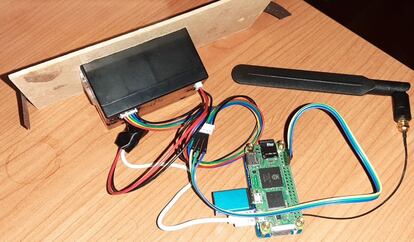Guido García misses his grandmother.
In the last two Christmases, the pandemic has prevented him from meeting with Ludi, 93, and a resident of Basauri (Vizcaya).
Nor could he communicate with her as he would have liked because, as he explains, Ludi "doesn't want any trouble, or Wi-Fi, or mobile."
So this telecommunications engineer residing in Valladolid, who feels like a pucelano even though he was born in Barakaldo in 1979, has developed an ingenious device based on basic technological elements so that the family can send texts and images to the old woman.
The result is a kind of homemade WhatsApp that includes a small printer, a ''mini computer'' or Raspberry Pi (the size of a credit card), and a SIM card to connect it to the internet.
Ludi will only have to plug it into the mains and wait for the photos.
More information
The grandson who invented Yayagram to communicate with Grandma Felisa
The images and texts are sent through Telegram, through a bot programmed by García.
When this software
development engineer
explained the gadget he was creating on Twitter, more than 2,000 people retweeted it, 280 replied, and more than 9,000 liked it.
''I was very surprised.
For once it goes viral, it caught me sleeping,'' he joked in a video call with EL PAÍS.
In the thread published on his profile, on January 10, García explained step by step how he had built this WhatsApp to walk around the house.
The idea was that her grandmother did not have to do anything at all.
The engineer programmed the bot in Telegram because, according to him, "it is more open than WhatsApp, where only companies can make a bot, it has to be approved by Facebook and sending messages costs money."
In a conversation chat like the one you use with any friend, you send a message or a photo to the bot, and it gives the print order to the machine.
Conversation with the bot programmed in Telegram.
Screenshot taken by Guido García.
The device prints in black and white. The Raspberry Pi "is more powerful than it seems," says Garcia. “It has half a gig of RAM. A desktop computer still reaches four gigabytes, so it has limited capabilities, but to do this type of applications or for home automation they are used a lot because they have very low consumption, they don't make noise, they don't get hot...'', he explains . The SIM card is used to obtain the internet connection and, therefore, with the bot. Since Grandma doesn't have Wi-Fi or a mobile phone, this was the easiest way to get it. When someone sends you a photo or message, you'll receive it on paper without having to do anything other than pick it up from the printer. All the components are contained in a box of strawberries, which is what I had at home. The project is finishedAll that remains is for him to take it to his grandmother so that he can release it.
This Christmas I made a pot to send photos to my grandmother who doesn't have a cell phone or internet.
The requirements were to spend a short time (~20h) + that I could plug it in and go + without maintenance.
– Guido (@palmerabollo) January 10, 2022
Although Guido García set out to complete the task in no more than 20 hours, in the end it took 40. Obtaining all the necessary components has not been difficult or expensive: ''The printer cost me about 50 euros, the Raspberry Pi with the SIM , 20 euros in total, the communication plate that carries the card, 70. In total, about 180 euros.
I had no budget constraints, but it can be done cheaper.''
García looks for components in specialized computer stores or online, and acknowledges that he has noticed a shortage of chips and components: ''There is less
stock
in some stores or the price has gone up a bit, but components like the Raspberry Pi are very common and you can find them in many places''.
The components contained in the box: the Raspberry Pi, the board that contains the SIM card, the connection cables... Image taken by Guido García.
The engineer knows that he is not a pioneer in homemade WhatsApps. He is well acquainted with Yayagram, devised by the Burgos computer engineer Manuel Lucio, and assures: ''I am not the first to do something like this, although, in this case, it is even simpler. The Yayagram is a similar idea, but more elaborate, it is not a passive device''. Thanks to the thread that he uploaded, some users have proposed alternative ideas to the ones he has had, and others have even asked him to make one for them. "There has been a very good reception," he insists. No one has yet written to him saying that he has put his idea into action, but he is convinced that "anyone with basic knowledge of electronics and programming can know how to do it."
You can follow EL PAÍS TECNOLOGÍA on
and
or sign up here to receive our
weekly newsletter
.













